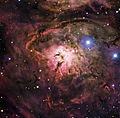Fayl:Lagoon Nebula.jpg
Naviqasiyaya keç
Axtarışa keç

Sınaq göstərişi ölçüsü: 610 × 599 piksel. Digər ölçülər: 244 × 240 piksel | 489 × 480 piksel | 782 × 768 piksel | 1.043 × 1.024 piksel | 1.841 × 1.808 piksel.
Faylın orijinalı (1.841 × 1.808 piksel, fayl həcmi: 2,92 MB, MIME növü: image/jpeg)
Faylın tarixçəsi
Faylın əvvəlki versiyasını görmək üçün gün/tarix bölməsindəki tarixlərə klikləyin.
| Tarix/Vaxt | Kiçik şəkil | Ölçülər | İstifadəçi | Şərh | |
|---|---|---|---|---|---|
| indiki | 00:20, 4 mart 2014 |  | 1.841 × 1.808 (2,92 MB) | Lmbuga | Putting the nebula in the center of the image |
| 07:48, 9 avqust 2012 |  | 2.027 × 2.064 (1,59 MB) | Fabian RRRR | higher resolution | |
| 07:32, 22 aprel 2010 |  | 1.280 × 1.303 (317 KB) | EricHS211 | {{Information |Description={{en|1=Infrared view of the Cat’s Paw Nebula (NGC 6334) taken by VISTA. NGC 6334 is a vast region of star formation about 5500 light-years from Earth in the constellation of Scorpius. The whole gas cloud is about 50 light-year |
Fayl keçidləri
Bu faylı istifadə edən səhifə yoxdur.
Faylın qlobal istifadəsi
Bu fayl aşağıdakı vikilərdə istifadə olunur:
- ady.wikipedia.org layihəsində istifadəsi
- alt.wikipedia.org layihəsində istifadəsi
- av.wikipedia.org layihəsində istifadəsi
- bn.wikipedia.org layihəsində istifadəsi
- cs.wikipedia.org layihəsində istifadəsi
- cv.wikipedia.org layihəsində istifadəsi
- de.wikipedia.org layihəsində istifadəsi
- en.wikipedia.org layihəsində istifadəsi
- et.wikipedia.org layihəsində istifadəsi
- fr.wikipedia.org layihəsində istifadəsi
- hu.wikipedia.org layihəsində istifadəsi
- kaa.wikipedia.org layihəsində istifadəsi
- kk.wikipedia.org layihəsində istifadəsi
- koi.wikipedia.org layihəsində istifadəsi
- ko.wikipedia.org layihəsində istifadəsi
- kv.wikipedia.org layihəsində istifadəsi
- lez.wikipedia.org layihəsində istifadəsi
- mdf.wikipedia.org layihəsində istifadəsi
- mg.wikipedia.org layihəsində istifadəsi
- mk.wikipedia.org layihəsində istifadəsi
- mrj.wikipedia.org layihəsində istifadəsi
- olo.wikipedia.org layihəsində istifadəsi
- os.wikipedia.org layihəsində istifadəsi
- pl.wikipedia.org layihəsində istifadəsi
- pt.wikipedia.org layihəsində istifadəsi
- ru.wikipedia.org layihəsində istifadəsi
- sah.wikipedia.org layihəsində istifadəsi
- sh.wikipedia.org layihəsində istifadəsi
- sk.wikipedia.org layihəsində istifadəsi
- sv.wikipedia.org layihəsində istifadəsi
Bu faylın qlobal istifadəsinə baxın.


